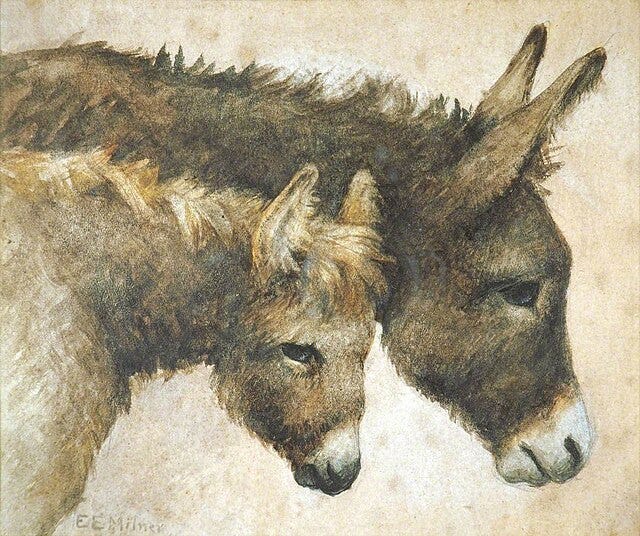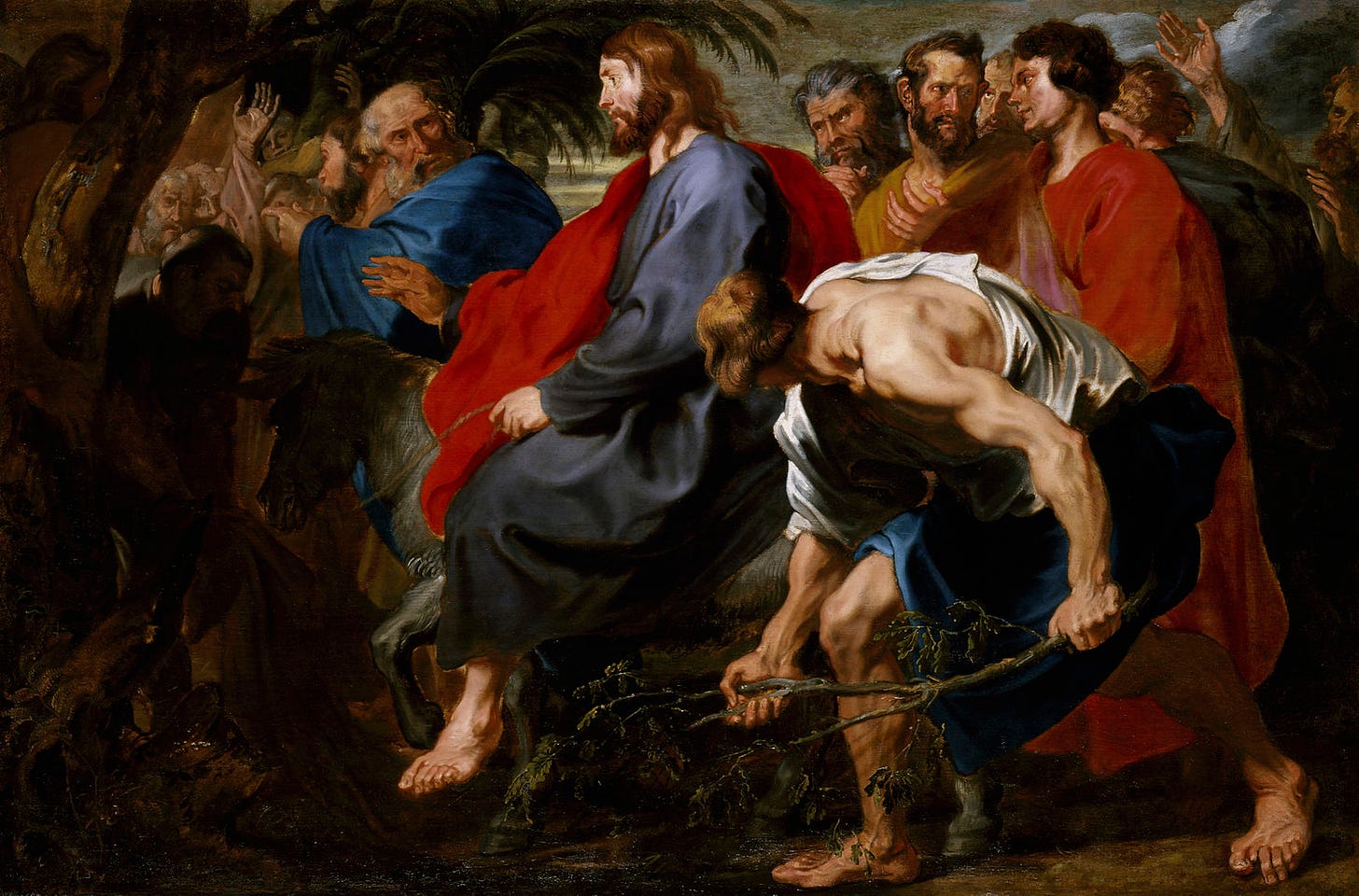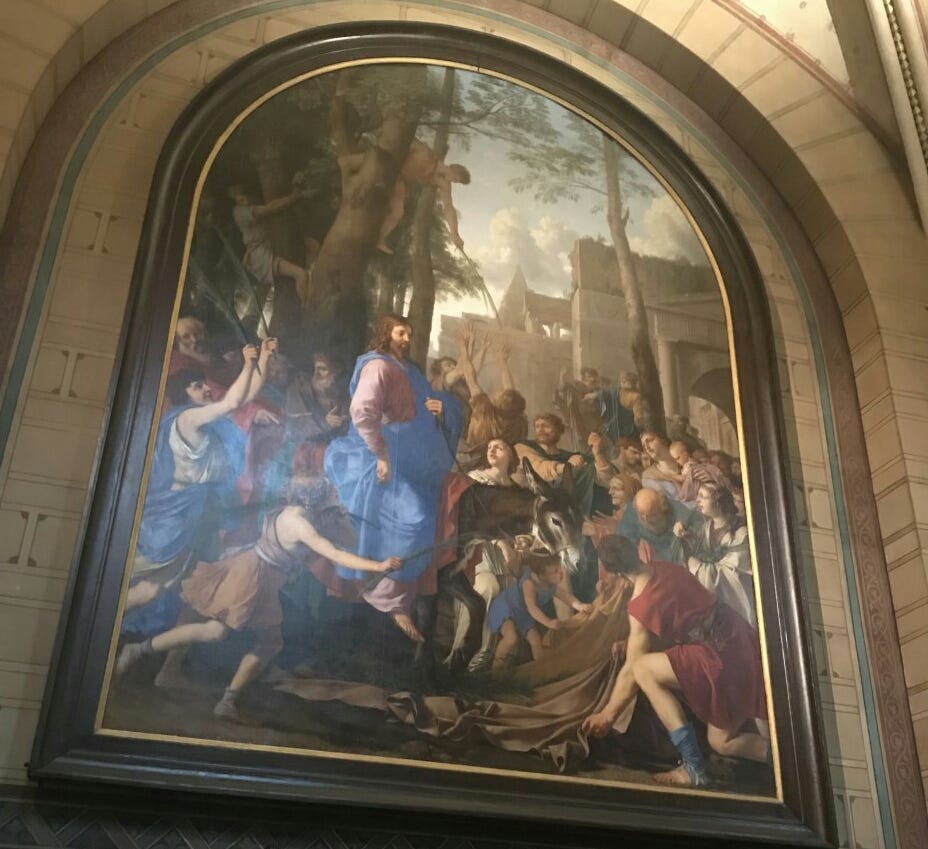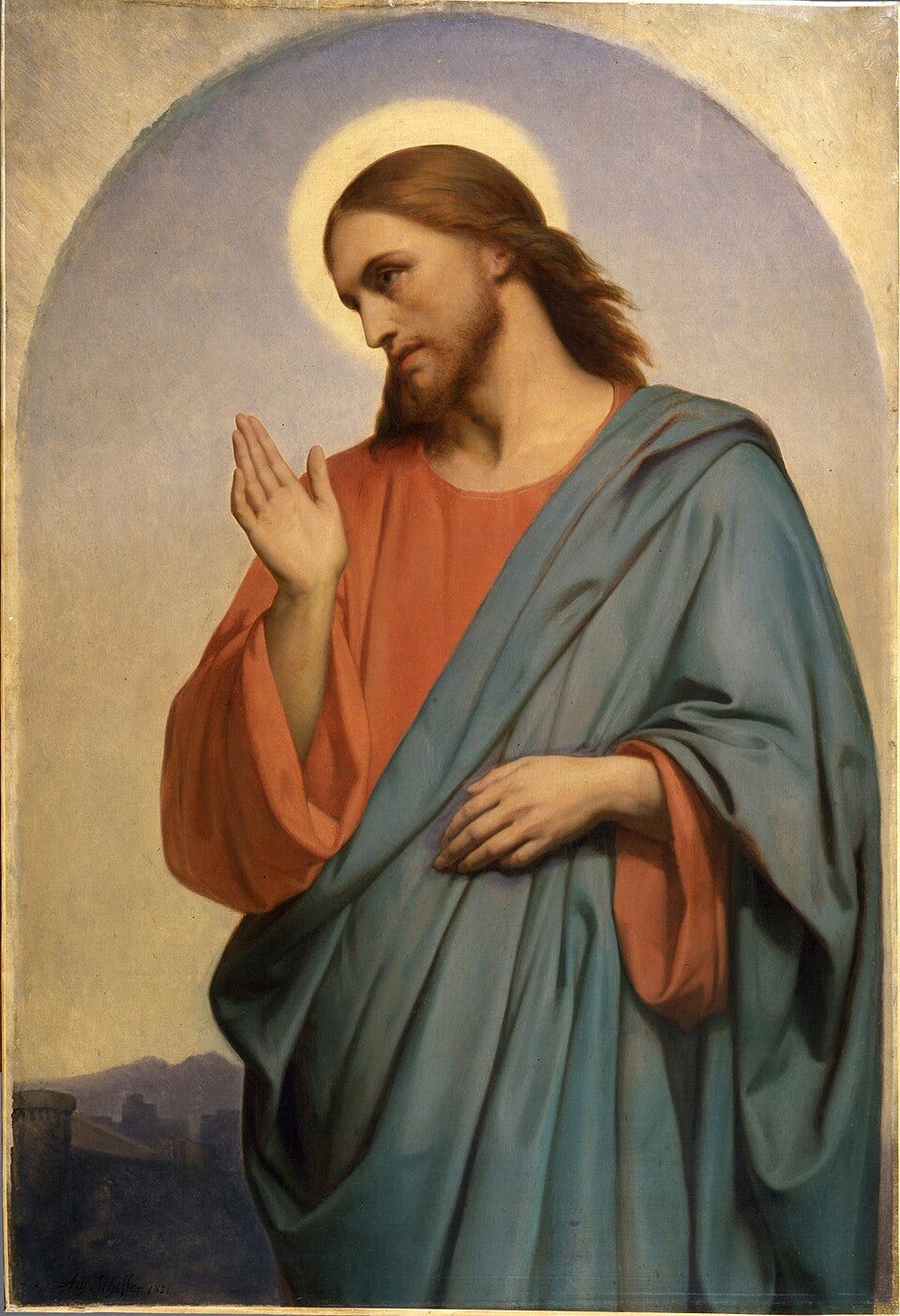A Holy Week Pilgrimage at the National Gallery London: Palm Sunday
A spiritual quest in the National Gallery during Lent 2024

“Rejoice greatly, O daughter of Zion! Shout, o daughter of Jerusalem! Behold your King is coming to you; He is just and having salvation, lowly and riding on a donkey, a colt, the foal of a donkey.”
Zechariah 9:9 (NKJV)
On Palm Sunday, when Jesus entered Jerusalem, indeed riding on the foal of a donkey, Zechariah’s prophecy from centuries before was fulfilled.
Imagine! Riding on a colt that had never been broken! That was certainly a miracle.
Today, Palm Sunday 2025, marks the onset of Holy Week, perhaps the most sacred time of the year for Christians. For me, it brings a sense of quiet contemplation and a holy focus on Jesus’s sacrifice for mankind.
Last year, it sparked some inspiration along with the inward going. During my (unexpected) three-month stay in London at the beginning of the year, I visited the National Gallery in London during Lent and was struck by the thought that I could give myself personal quests at the Gallery, at the British Museum, at the Louvre, and anywhere at all in the whole wide world. I could come with a theme, or a question in mind, and search for paintings and works that fit that theme, and/or answered that question.
(I just told my daughter that works on the female artists in the gallery would be a fun one. There’s a few there, including one of my favorites, Artemesia Gentilleschi.)
So, that day, I decided to hunt for paintings depicting scenes from Holy Week and see what I could find. I proceeded to walk my way through the Gallery (quickly, it was soon closing) and if a painting fit the theme, I took a quick shot of it and its name to research later and continued on my way.
I viewed every viewable painting on all three levels of the Gallery. The Byzantine collection downstairs was particularly great. (What is it about gold leaf in the Byzantine Period and Middle Ages? Perhaps it signifies the holy?)
It was a great adventure. And, now with a new Lenten season upon us, it’s great to finally share the quest findings with you.
Today, I’d love to show you what I found at the Gallery which depicted Palm Sunday and the Triumphal Entry.
I’d love to show you…if there had been anything.
But the entry into Jerusalem was not there.
Nope. Nothin’.
It appears to not be represented at all at the National Gallery, as far as I saw on my rapid walk through the art spaces that day.
I wish I could have seen a painting that showed at least one of the significant events occuring that day:
Jesus’s descent from the Mount of Olives down toward Jerusalem with His disciples.
The donkey and its foal, and the two disciples who took it, and Jesus riding upon it. (Jesus knowing exactly where the donkey and foal were and that the owner would relinquish it is a supernatural gift from the Holy Spirit - redundant? perhaps all gifts from the Holy Spirit are supernatural? - producing a miracle called a Word of Knowledge, that is, knowing something that you really shouldn’t know except by God.)
All the people gathering and laying their robes, clothes, and leafy branches and palm branches down in recognition of, and to honor, Jesus as King as He entered Jerusalem (at least on that day; their fickleness would soon, within a week’s time, result in the greatest dishonoring in history)
As Jesus neared Jerusalem, His weeping over Jerusalem. Because the city did not recognize its Saviour, the city would follow other leaders which would result, in a few decades’ time, in certain destruction by Emperor Titus. And Jesus knew this and wept over the suffering and pain soon coming to His people. He so wanted them to recognize Him for who He truly was.
No, the National Gallery in London has none of these thematic scenes represented.
I went searching further, though, and found works elsewhere which do depict elements from this day:
Interestingly, the Indianapolis Museum of Art has Anthony van Dyck’s oil painting Entry of Christ into Jerusalem from 1617. (How did Indiana get this one??? Anthony van Dyck? In Indiana?)

Giotto di Bondone, Entry into Jerusalem (c. 1305) Fresco, Scrovegni Chapel, Padua, Italy. (The oldest painting listed here. 1305! And yet, with perspective and life and realism…The brilliance of Giotto.)

Giotto di Bondone, Entry into Jerusalem (c. 1305) Fresco, Scrovegni Chapel, Padua, Italy. Wikimedia Commons (Notice the palm trees? And an olive tree, too?) Pietro Lorenzetti, Entry into Jerusalem (c. 1320) Fresco, Lower Basilica of San Francesco, Assisi, Italy.

Pietro Lorenzetti, Entry Into Jerusalem (c. 1320) Fresco, Lower Basilica of San Francesco, Assisi, Italy. Wikimedia Commons (Hmmm…I wonder what types of palm trees those are. Any guesses?) (1)
Jean-Hippolyte Flandrin, Entry into Jerusalem (c. 1842–1848) Fresco, Saint-Germain-des-Prés, Paris, France. (That’s likely in the 6th Arrondissement. Where in the 6th Arrondissement? Oh! It’s at the church! L'église or L’abbaye Saint-Germain. I once walked into that very old Gothic massive beautiful place while a wedding was happening! That’s the only time I’ve ever crashed a wedding! Would do it again in a heartbeat!)
[Unfortunately, I’m not able to show Flandrin’s beautiful fresco cycle due to licensing concerns but I’ll send you to Adobe Stock here to take a look.]
Laurent de La Hyre, Entry of Christ into Jerusalem (L'Entrée de Jésus à Jérusalem) (c. 1606-1656). Oil on canvas, bas-côté Nord de l'église Saint-Germain des Pres

Laurent de La Hyre, Entry of Christ into Jerusalem (L'Entrée de Jésus à Jérusalem) (c. 1606-1656). Oil on canvas, bas-côté Nord de l'église Saint-Germain. Photo by Thomon. Wikimedia Commons. Ary Scheffer, Christ Weeping Over Jerusalem (c.1851) Oil on canvas, Victoria and Albert Museum, London, UK (That’s not super terribly far from the Gallery!)

Ary Scheffer, Christ Weeping Over Jerusalem (c.1851) Oil on canvas, Victoria and Albert Museum. Wikimedia Commons James Tissot, Jesus Wept (Jésus pleura) (c.1886–1896) Opaque watercolor over graphite on gray wove paper, Brooklyn Museum, New York, USA (I must visit this museum.)

James Tissot, Jesus Wept (Jésus pleura) (c.1886–1896), Brooklyn Museum. Wikimedia Commons
The celebrated bronze doors of the Baptistery, specifically the North Doors, with gilded bronze panels by Ghiberti (1403-1424), adjacent to the Cathedral (Duomo) of Florence (Firenze), do have a specific panel of the Entry Into Jerusalem. (These doors are masterworks. So much detail in such a tight space…)

Although the Gallery was short on depictions of the Triumphal Entry by Jesus into Jerusalem, I’m glad there are paintings elsewhere showing the high drama, the emotion, and the foreshadowing of what is to come in just a few days’ time. Had the Gallery carried paintings on this subject, I’m certain I would not have delved further and would have not known what I had missed. And I’m sure I’ve only scratched the surface.
And I did also find The Chosen’s representation of Palm Sunday, a compelling preview for Holy Week, and it, along with the artworks above, carried me straight into what that day could very well have been like:
Do you have a favorite from the depictions presented?
I am always amazed at the exactitude of the Baptistery’s bronze panels. So much detail…
And my heart feels the pain of Jesus in Tissot’s Jesus Wept. As a burgeoning watercolorist, I love that he used that medium, too.
I wish we could all meet at L’Abbaye Saint-Germain-des-Prés in Paris and just stare up at those frescoes for however long we choose…
The quest started in London but ended up extended to other countries, churches, and museums. A lovely journey at the beginning of Holy Week. An unexpected adventure into visual historical interpretations of Jesus’s Triumphal Entry…
“Then, as He was now drawing near the descent of the Mount of Olives, the whole multitude of the disciples began to rejoice and praise God with a loud voice for all the mighty works they had seen, saying: ‘Blessed is the King who comes in the name of the Lord!’ Peace in heaven and glory in the highest!
And some Pharisees called to Him from the crowd, “Teacher, rebuke your disciples.’
But He answered and said to them, ‘I tell you that if these should keep silent, the stones would immediately cry out.’”
Luke 19:37-40 (NKJV)
Most likely the palm branches used on Palm Sunday were from the date palm (Phoenix dactylifera).
Phoenix : Greek (φοῖνιξ, phoinix)
Mythological: The phoenix, a mythical bird reborn from ashes, symbolizing renewal and immortality. (A perfect representation of death and resurrection.)
Botanical: In ancient Greek, phoinix also referred to the date palm, possibly due to its resilience and ability to thrive in harsh desert conditions, evoking a sense of rebirth.
Cultural: The term may link to the Phoenicians, a seafaring Mediterranean people who traded dates and spread palm cultivation, associating the tree with their name. Pliny the Elder and Herodotus use phoenix for both the bird and the palm, suggesting a shared symbolic vitality.
dactylifera:
dactylus: From Greek δάκτυλος (daktylos), meaning “finger,” referring to the shape of the date fruit, which resembles a finger in size and form.
-fera: From Latin ferre, meaning “to bear” or “carry,” a common suffix in botanical names for fruit-bearing plants (e.g., pomifera for apple-bearing)
Symbol of Abundance: Dates were a staple in Judea, sustaining life in the desert. Their abundance reflects the life-giving promise of the resurrection, where Jesus’s sacrifice yields spiritual nourishment for believers (John 6:35, “I am the bread of life”).
Liturgical Echoes: In Jewish tradition, palm fronds were used in the Feast of Tabernacles (Leviticus 23:40), symbolizing joy and God’s provision. On Palm Sunday, these fronds acclaim Jesus, whose resurrection ensures eternal provision—salvation. The “finger-bearing” palm, laden with fruit, prefigures this divine generosity.
Relevance: The palm’s depiction in art reinforces its role as a resurrection symbol, with Phoenix dactylifera’s etymology enhancing the narrative arc from Palm Sunday to Easter.
Thanks, Grok! (I love Grok! It’s like the encyclopedia set my mom got me as a child, only with endless answers to all my questions.)




Love this Renate! Hard to believe there was nothing in the National Gallery in London, but I guess the Palm Sunday scenes are not dramatic enough for most artists LOL
Personally, my favorite from this post is Jesus Wept. I am always drawn to the lesser celebrated scenes and the ones that are most relatable.
BTW, fabulous idea to give yourself a theme! I am borrowing that from you. We should meet up and explore themes together!
Hey, this is great!
Apparently with a recent update of the app, my feed was all out of order, but I figured it out. Now I see you’ve been posting for Holy Week—thank you. The pieces you’ve found and included are lovely. I don’t recall if I’ve ever seen any of those works before. I am also surprised you had to search so much for a Palm Sunday depiction!
Thank you also for including that spot from The Chosen. I haven’t kept up with that series. (Though I just found a series on King David that I’m watching on Prime. It’s really good and it’s called House of David.)
Now that my feed is back in order, I can keep up with your posts. So happy to see my notifications when you post an entry! 🤗🤗